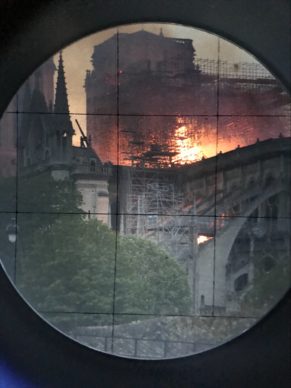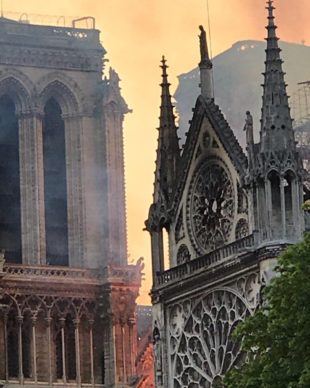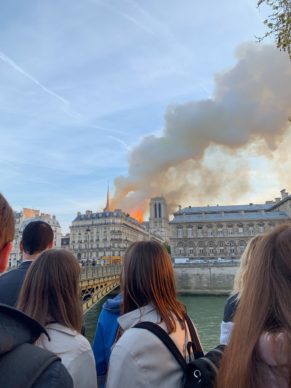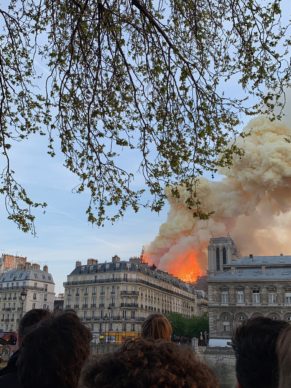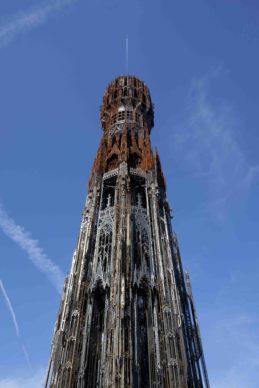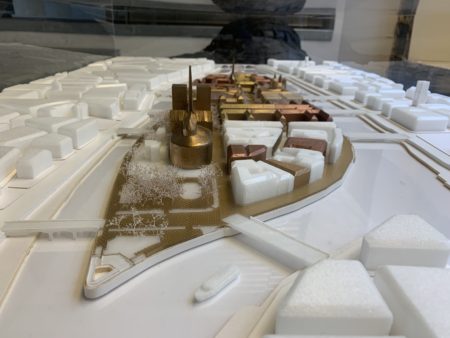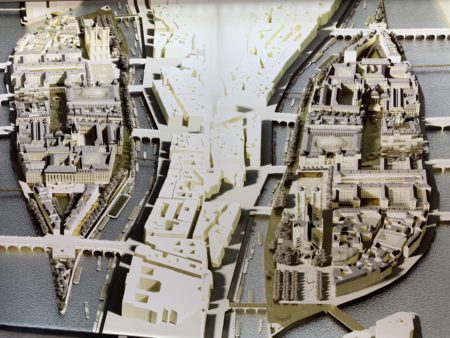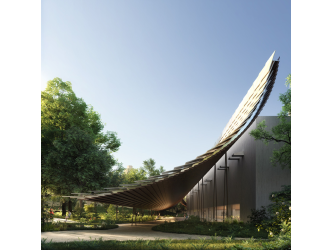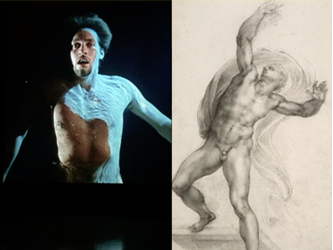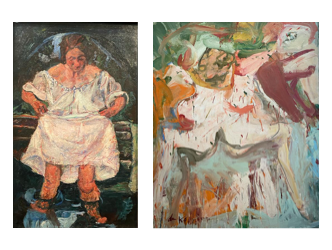The exact time at Notre Dame
It’s a beautiful late afternoon in springtime in Paris. One of those delightful afternoons when the trees are bursting into bud and young people chirp and coo outside cafes.
I can remember the exact time, because I have a routine medical appointment on the Île de la Cité and I am running late.
A yellow smoke
19:05. Impossible to take the route leading to Notre Dame. It’s been cordoned off by the police. This kind of diversion is commonplace these days, in the age of the gilets jaunes and risks of terrorist attacks. Skirting around the monumental 13th-century church to get to my appointment, I glimpse a thick plume of canary-yellow smoke rising up into the sky. It’s coming from behind the building, or from beside it perhaps? Yes, that must be it. Because surely it can’t be coming from Notre Dame. I mention it in passing to the doctor at my appointment. I’m surprised by the colour of the smoke. I’ve never seen smoke like that, so yellow.
It’s always been there
At the doctor’s practice, the smell of burning is beginning to spread. But nothing, surely, could happen to Notre Dame. It’s always been there. It will always be there. That’s just how it is. About half an hour later the consultation is over, and I find myself in this little street in a Paris from the Middle Ages. Immediately, I am firmly instructed by the police to leave the island de la Cité via the bridge that leads to the Hôtel de Ville. I still take a moment to joke with one of the female members of law enforcement, who looks more like a model than a police officer, slender and graceful in her navy-blue uniform which is usually so unglamorous.
Fierce flames
As I walk away I phone the doctor to warn her that she should also leave her office, and I join the crowds forming on the quai at the Hôtel de Ville. I turn around and I realize what’s actually happening: fierce flames are devouring the structure and shooting into the sky. The proof is there in front of me: anything can happen to Notre Dame, too. But I just can’t believe it. People walking past stop and stare. They all stand there, mouths wide open in disbelief.
Notre Dame spire falls
Then suddenly the cathedral spire, rebuilt by the visionary 19th-century architect Eugène Viollet-le-Duc, which has been engulfed in flames, falls. It breaks in two before our very eyes, all of us dumbstruck. It just collapsed. Anything can happen to Notre Dame. A clamour swells through the entire crowd. Around me several people are silently weeping. The sight is unbearable. A part of our culture has fallen with the collapse of the spire, which stretched up towards the sky. There are some people who have dared compare it to the attack on the twin towers in New York, but in my view this parallel is inappropriate. This is because, thanks to the efficiency of the firefighters and police forces, the partial destruction of Notre Dame didn’t result in any injuries or deaths.
At the quai I can’t bear to stand there in the crowds watching the spectacle of the great Lady of Paris being consumed by flames. I walk in the other direction to the Parisians streaming past me on foot, and in great numbers, towards the site opposite the fire. I encounter various colleagues of mine. I write to my daughter in the United States, who’s already aware of what’s happening. I receive a message from my friend, an Italian priest. Another from my Muslim friend in Abu Dhabi.
It takes a full day and a half for my journalistic reflexes to kick in, arousing me from my deep stupor.
The largest donors
Far from the controversies over who’s giving what and who’s deducting what for tax purposes, I went to see and film two of the three largest donors to the reconstruction of Notre Dame, who are pledging colossal sums.
The Bettencourt family
Olivier Brault is director general of the Bettencourt Schueller Foundation, who has pledged a donation with the Bettencourt family, owners of l’Oreal, for 200 million euros.
The Arnault family
Jean Paul Claverie is advisor to Bernard Arnault, owner of the world leader in luxury LVMH, who is promising a donation of 200 million euros (with no application of lower taxes).
The Pinault Family
Kering, embodied by François-Henri Pinault and his father François Pinault, have contributed a donation of 100 million euros through their family investment firm Artemis. Jean Jacques Aillagon, advisor to François Pinault, was away at the time but he contributed these few words.
“It was while watching the images of Notre Dame ablaze, during the night of Monday 15 to 16 April, that François-Henri Pinault and his father François decided to contribute to the restoration of the Cathedral with a donation of 100 million euros. Neither of them could imagine not sharing, at this moment, in the emotion of the French people, which is also being expressed around the world. It was with satisfaction that they observed the next morning that the initiative they had taken had inspired others and that, as one thing led to another, the necessary funds for the restoration of Notre Dame would soon be raised.
To nip in the bud any controversy over the potentially self-interested nature of the decision they have made, they have also decided to announce that they did not, at any point, envisage that their contribution might benefit from the application of lower taxes linked to participating in sponsorship. It was a donation, pure and simple, that the Pinault family made as a result of their desire to take part in the restoration of the emblem of Paris that is Notre Dame.”
Larry Gagosian
The Art Dealer Larry Gagosian has announced :”I wish to contribute to the reconstruction of this iconic cathedral”. Gagosian will mount an exhibition at the Paris gallery in June to support the rebuilding of this irreplaceable historical monument which will include works by both modern and contemporary artists.
The artists
Lastly, there have been reactions from many artists and architects in the wake of the fire at Notre Dame.
Wim Wenders
– Wim Wenders, the German filmmaker who was passing through Paris to stage an exceptional performance at the Grand Palais, confesses that he cried when he saw the fire.
Ai Weiwei
– The Chinese artist Ai Weiwei, who is currently in New York, spoke to me over Skype about the need to take into consideration the current global context in terms of the destruction of humanity’s treasures.
Wim Delvoye
Wim Delvoye issued a press release on 18 April expressing his wish to participate in the reconstruction of Notre Dame: “Delvoye has been known as a contemporary Viollet-Le Duc since the early 2000s because of the reinterpretation of the Northern European Gothic style that he uses as a source of inspiration for the corpus of Gothic Works that he has since developed”.
Annette Messager
The French artist Annette Messager remembers the first time she visited Notre Dame as a teenager, where she saw the old 13th-century rose windows casting colourful reflections down onto the cathedral floor, like an installation.
Dominique Perrault
The architect Dominique Perrault, designer of the French National Library, Bibliothèque Nationale de France, among other things, who conceived the plan for the future Olympic village in Paris in 2024, was tasked by the French president at the time François Hollande with the mission of conducting an urban study on the Île de la Cité in 2015.
He spoke to 150 people about the area classified as a world heritage site by UNESCO and submitted a report on the topic in 2016, which was the subject of a book and an exhibition (http://www.missioniledelacite.paris). Today he advises, in an innovative way, that the reconstruction should be carried out while taking the whole island into account in its reconfiguration.
Douglas Gordon
And finally, the Scottish artist Douglas Gordon, who lives between Paris and Berlin, wrote a text after the fire:
The myth of sanctuary. Tuesday, April 16th, 2019-04-16
————————-
As I am watching in Berlin, in a safe, warm place.
My studio.
I watch images of a burning building.
again.
Not the macintosh school in Glasgow this time – but a strangely similar, familiar scene.
An accidental disaster.
Not a natural disaster.
Not an act of sabotage.
a disaster designed ?
No.No.No.
An accidental tragedy.
That’s life.
A living building, falling apart before our very, living eyes.
That’s enough.
a Slow death, slightly.
but the flames accelerate beyond belief.
out of time.
in time, we are witnessing the real-time corruption of a living thing.
the heat and the flames are rampant – virus, beyond belief, again, and again, relentless, BLIND, WITHOUT DISCRIMINATION.
endlos.
Do buildings resist the end?
Did the roof implode – the tinderbox, in effect – in order to save the remainder of the stone structure?
The building was, is, and remains a sanctuary to many stories, multiple interpretations and will maintain the abstract idea of ‘the monumental’, despite and potentially embracing the brutal spectacle that we have witnessed in the last few hours.
It’s simply a building – its more than a building – it plays host to more than one inhabitant.
As Charles Laughton screamed, as Quasimodo,
“Sanctuary, sanctuary, sanctuary”.
No-one wants to witness sanctuary burning.
Sad.
Flames expire.
Support independent news on art.
Your contribution : Make a monthly commitment to support JB Reports or a one off contribution as and when you feel like it. Choose the option that suits you best.
Need to cancel a recurring donation? Please go here.
The donation is considered to be a subscription for a fee set by the donor and for a duration also set by the donor.


